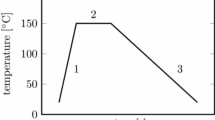Abstract
A numerical approach using the boundary element method for strength and toughness of a composite with long aligned fibers is reported. The three-dimensional problem is reduced to a two-dimensional one by substituting the rows of fibers with layers of appropriate width and elastic constants. The configuration examined in this work is a compact tension specimen similar to that used in the experimental studies (Part I, [1]). The experimental results on strength and apparent fracture toughness are compared with the numerical results. For the particular geometry and fiber spacing, the numerical simulations are in good agreement with the experimental findings, i.e. the composite's strength σ A , scales with the fiber spacing λ, in the form of σ A . Using the numerical formalism a number of different geometries was examined. The simulations suggested that if the external specimen characteristics remain the same and the fiber spacing in the direction of crack advance is changed, then the strength of the composite specimen can be expressed σ A . If the fiber spacing varies in both directions simultaneously, for a certain range of λ, it can be considered that the composite's strength σ A , is proportional to σ A .
Similar content being viewed by others
References
D. Zhao and J. Botsis, Experimental and numerical studies in model composites. Part I: Experimental results. International Journal of Fracture 82, 153–174.
A.F. Bower and M. Ortiz, A three-dimensional analysis of crack trapping and bridging by tough particles. Journal of the Mechanics and Physics of Solids 39 (1991) 815.
N. Fares, Crack fronts trapped by arrays of obstacles: numerical solutions based on surface integral representation. Journal of Applied Mechanics 56 (1989) 837.
H. Gao and J.R. Rice, A first-order perturbation analysis of crack trapping by arrays of obstacles. ASME Journal of Applied Mechanics 56 (1989) 828.
J.R. Rice, First order variations in elastic fields due to variation in location of a planar crack front. ASME Journal of Applied Mechanics 52 (1985) 571.
K. Fujino, H. Sekine and H. Abe, Analysis of an edge crack in a semi-infinite composite with a long reinforced phase. International Journal of Fracture 25 (1984) 81.
A.A. Rubinstein, Macrocrack-microdefect interaction, ASME Journal of Applied Mechanics 53 (1986) 505.
F. Erdogan, G.D. Gupta and M. Ratwani, Interaction between a circular inclusion and arbitrarily oriented crack. ASME Journal of Applied Mechanics 41 (1974) 1007.
B.A. Crouch, The effect of crack front curvature and side-grooving on three point bend specimen fracture toughness measurements. International Journal of Fracture 52 (1991) 275.
M.L. Luchi and S. Rizzuti, Boundary element analysis of CT specimens with straight and curved crack fronts. International Journal of Fracture 34 (1987) 23.
D.N. Fenner and M.J. Abdul Mihsen, Crack front elastic stress state for three-dimensional crack problems. International Journal of Fracture 25 (1984) 121.
O.L. Towers and A.P. Smith, Stress intensity factor for curved crack fronts in compact tension specimens. International Journal of Fracture 25 (1984) R43.
Y. Yamamoto and Y. Sumi, Stress intensity factor for three-dimensional cracks. International Journal of Fracture 14 (1978) 17.
J. Alam and A. Mendelson, Effect of crack curvature on stress intensity factors for ASTM standard compact tension specimens. International Journal of Fracture 23 (1983) 317.
A.A. Becker, in The Boundary Element Method in Engineering, McGraw-Hill, New York (1992).
T.A. Cruse, in Boundary Element Analysis in Computational Fracture Mechanics. Kluwer Academic Publishers, Dordrecht (1988).
H. Tada, P. Paris and G. Irwin, The Stress Analysis of Cracks Handbook, Del Research, Pennsylvania (1973).
Author information
Authors and Affiliations
Rights and permissions
About this article
Cite this article
Beldica, C., Botsis, J. Experimental and numerical studies in model composites Part II: Numerical results. Int J Fract 82, 175–192 (1996). https://doi.org/10.1007/BF00034662
Received:
Accepted:
Published:
Issue Date:
DOI: https://doi.org/10.1007/BF00034662




